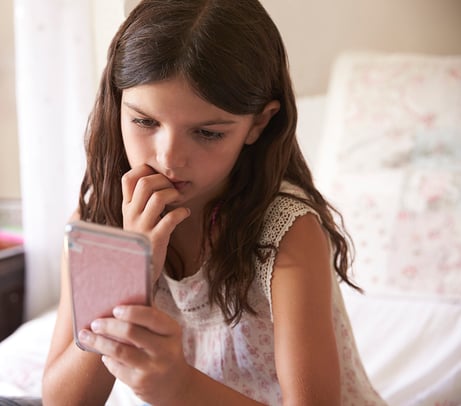Bullying is an unpleasant and damaging experience no matter how it happens. Most of us can clearly remember an episode of bullying as it leaves a lasting impression. It’s frightening, shaming and destroys self-confidence.
Traditional bullying takes place face-to-face. It’s the taunting of mean comments, unpleasant name-calling or physical attacks. More recently bullying has taken on a new variation - cyberbullying. It can be unfamiliar territory and extremely difficult to understand. But it’s important that we get to grips with the new challenges that our children face, so we’re in the best possible position to support and care for them.
So what exactly is cyberbullying, and how does it differ from the traditional form of bullying?
What Is Cyberbullying?
Cyberbullying is the name given to the type of abuse that happens across digital technologies such as; social media, messaging platforms, gaming platforms, mobile messaging and email.
Bullies target individuals repeatedly by shaming, belittling and scaring them across these new interfaces. This can look like:
- Posting pictures or videos of the target across social media or messaging platforms to ridicule and make fun of.
- Sending abusive direct messages or emails to induce fear.
- Name calling and exclusion across gaming platforms.
There are many other tactics besides these, and they’re all frightening and distressing. Of course, cyberbullying doesn’t have to happen exclusively, and often takes place alongside traditional face-to-face bullying.
However there are differences that make cyberbullying a particularly worrying development.
What Makes Cyberbullying Different?
Anonymous
 One of the biggest differences between cyberbullying and traditional bullying, is that it can be carried out completely anonymously. Online, a bully can be whoever they decide to be. Their true identity can be easily hidden under a pretend name and a random picture. Under a false guise, the perpetrator is emboldened to act more viciously than they would in a face-to-face encounter. The victim has no idea who their bully is, which is particularly upsetting as it elevates a sense of mistrust in others. It also keeps them in a state of paranoia, as they wonder who might be responsible for attacking them.
One of the biggest differences between cyberbullying and traditional bullying, is that it can be carried out completely anonymously. Online, a bully can be whoever they decide to be. Their true identity can be easily hidden under a pretend name and a random picture. Under a false guise, the perpetrator is emboldened to act more viciously than they would in a face-to-face encounter. The victim has no idea who their bully is, which is particularly upsetting as it elevates a sense of mistrust in others. It also keeps them in a state of paranoia, as they wonder who might be responsible for attacking them.
Disconnected
Cyberbullying is a very disconnected behaviour. The bully can easily act unjustly with little to no repercussions. They cannot see the immediate effects of their behaviour on others; sitting behind a screen completely removes them from the seriousness of the situation. They’re less likely to consider their poor behaviour problematic, and therefore feel no guilt or remorse.
Face-to-face bullying on the other hand puts the bully in front of the target, the impact of their words and actions are immediately visible. There is no hiding or disconnect from the reality of their choices, making it more likely that they’ll reflect and reconsider their behaviour.
Unceasing
When bullying occurs in person, the bullies and the victim are in one another's company. This limits the frequency and duration of the abuse. However, cyberbullying can happen anytime, anywhere. Bullying over the internet through direct messages or digital platforms, means the abuse can continue 24/7 without reprieve.
The victim cannot escape or ever feel safe. Mobile devices are constantly carried around and provide a ‘direct-line’ to an individual. Bullying is always terrible, but it is possible to escape face-to-face bullying. Cyberbullying is merciless in its approach to pester and abuse someone with the tap of a finger, day and night.
Accessible
There’s few places in the world without internet connection. It’s affordable and essential in modern-day life, and most young people have their own mobile device connected to the internet at all times. This makes cyberbullying quick and easy. Add to that the anonymity factor and cyberbullying can become a hobby for some.
Face-to-face bullying takes more commitment, and with the risk of getting caught, it can be enough to put off the most ardent bully.
Permanent
Bullying leaves a lasting impression on the target, no matter how it’s carried out. But there is a permanency to cyberbullying that isn’t experienced with traditional types of bullying. When bullies post abuse online, the information is forever remembered. Stored online, it’s available to see forever. It’s often linked to the victim’s name, and leaves a lasting mark online as well as on the person. This can be particularly damaging and difficult to move past since it’s a constant reminder of the offense.
For All To See
Many acts of cyberbullying happen across digital platforms with audiences reaching into the billions worldwide. When a bully attacks online using these techniques, there is added humiliation because so many people are able to see it.
Traditional bullying rarely has an audience, it usually happens fairly discreetly and the victim is not usually humiliated in front of others. If an embarrassing video or picture is posted online, the victim is traumatised by the fact that millions of people have seen them; it’s humiliation on an epic scale.
Difficult To Monitor
Online comments and messages, although anonymous, are available for all to see. This is an advantage if wanting to gather evidence against a bully or prove wrongdoing. But with the rapid nature and extensive use of cyberbullying, it can be extremely difficult to monitor. Online platforms have a responsibility to keep their users safe, and many of them work hard to crack down on hateful speech and behaviour.
However, it’s impossible to keep track and remove every abuse, let alone prevent it in the first place. Many types of cyberbullying also happen on private chats or through text messages and emails. These are not monitored and this form of cyberbullying can be very covert, with no-one else aware of the problem, let alone able to step in and protect the vulnerable and hold the bullies to account.
What You Can Do
It’s important to remember that face-to-face bullying still happens, it hasn’t gone away, and is often used in tandem with cyberbullying to intimidate the victim. Cyberbullying is especially challenging and problematic because of its easy, constant and covert nature. So what can you do to protect the young people in your life?
Spend Time Together
It’s so critical that you spend quality time together. This keeps the door open for honest communication and the opportunity to share difficulties. So much shame is attached to bullying, it’s important the young people in your life feel able to trust you with what’s happening. Quality time builds secure relationships, where even the most challenging topics feel possible to disclose. You’re also more likely to notice even small changes in behaviour if you foster a close relationship.
Set Guidelines
Just as you have guidelines about where your young person spends their time and how late they stay out - to protect them, make sure you do the same for their digital presence too. You may decide to have time restraints for mobile devices or around access to certain platforms. Remember, there are guidelines for social media and online gaming concerning age appropriateness. Learn what these guidelines are and consider the emotional intelligence of the child in your care, before deciding whether it’s safe to use. Where possible you can turn off chats for online gaming or select safe modes to protect against negative comments or language.
Cyberbullying is worrying and has detrimental effects on victims. Whilst any kind of bullying is harmful, this new era of bullying can be hidden and go unnoticed. Many adults are unaware of the risk facing young people across digital platforms and technologies. With knowledge about the issues, and by maintaining good connections with our young people, we can guide and protect them through the challenges they face.
To learn more about how to stop the cycle of bullying take a look at our Not A Victim platform. A dedicated resource for parents and children and how we can help mentor the whole family through bullying.


